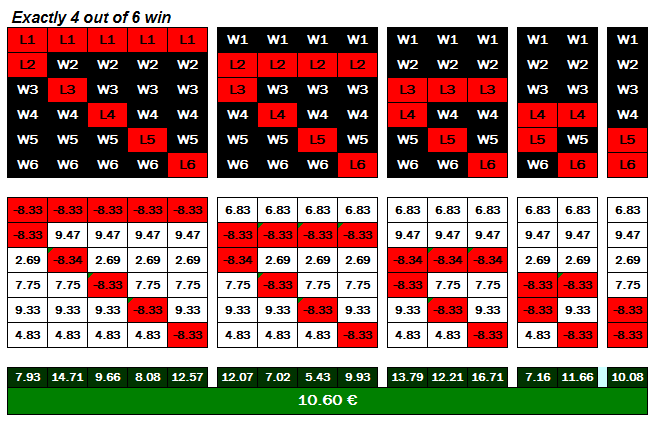
A Beautiful Mind
Introduction to Combinatorics and Probability Theory
This article is a step-by-step guide explaining how to compute the probability that, for example, exactly 4 out of 6 picks win, or how to calculate the likelihood that at least 4 of 6 bets win.
To help your understanding of this topic you will need to comprehend the basics of football result probability calculations, which I explained in detail in the article Calculation of Odds: Probability and Deviation.
The Basics of Probability Computation in Football Betting
The following picks table contains 6 value bets including the calculated probabilities for each bet to win:

Of the 6 published picks, 4 won and made a profit of 19.9% on the 50.00 € betting bank. I will now attempt to explain the mathematics behind the above selections.
The calculation of the probability that all 6 Picks will win is relatively easy and requires no knowledge of difficult formulas. You simply multiply together the given probabilities, thus:
The result of 6.3% is the probability that all 6 picks in the portfolio win.
Of course, the other end of the scale is that all 6 picks will lose. Again, this is a straight forward calculation: simply multiply the opposing probabilities to those used in the ‘win’ scenario, thus:
The result of 0.1973% is the probability that all 6 picks lose.
Summary:
- Probability that all 6 Picks win: 6.3%
- Probability that all 6 Picks lose: 0.1973%
If you divide 6.3% by 0.1973% the result is 31.93. This means the probability in this particular portfolio that all 6 picks win is almost 32 times higher than the probability that all 6 picks lose.
Practically speaking, there is a 32 times higher chance of winning all 6 bets and cashing 40.90 € profit than losing all 6 bets together with the entire 50.00 € starting bank.
Accumulated Betting Odds
- To win all 6 picks: 15.9 (1 divided by 6.3%)
- To lose all 6 picks: 506.7 (1 divided by 0.1973%)
These odds express that on average all 6 selected bets should win once in every 16 rounds and only once every 507th round should a total loss of the portfolio occur.
A single season’s football league betting will usually comprise approximately 80 rounds of matches (midweek and weekend betting). This means that statistically a total loss may happen once every 6.3 years betting on a similar portfolio to the example above each time. Of course, it could happen more often as wins and losses have a nasty habit of not lining up as cleanly as statistical theory says they should. For example, 2 total losses could occur in the first 2.6 years and then no more for another 10 years.
What is the probability that exactly ‘X’ picks win or lose?
Further interesting questions include what are the probabilities that exactly 5 of the selected 6 picks win, or at least 4 of the picks win, and following this, it is natural to ask whether it is viable to make long-term profit on this type of portfolio and if so, how much?
An easy starting point for assessing whether a portfolio is ‘worthwhile’ is by calculating the ‘expectancy’, in other words, how many of the picks are likely to win. This is simply the average of the win probabilities of the selected picks:
This value means that by betting on the above portfolio a success rate of 63.55% is ‘expected’, which would correspond to a hit rate of 4 from 6 picks (i.e. 6 [picks] times 63.55% = 3.81 [roughly 4 picks]). This means that on average this portfolio should usually bring around 4 successful picks. However, it is obviously necessary to check if the combination of 4 successful picks and 2 failed ones will produce a profit:

The above illustration shows that every combination of 4 picks from our 6-match portfolio would have returned a profit of between 7.02 € and 16.71 € depending upon the combination.
Important Note
Please note that the average value (expectancy value) does not mean a 63.55% probability that exactly 4 picks will win every betting round. The average value indicates that if you bet on this type of 6-match portfolio often enough, an ‘average’ of 4 hits can be expected.








Hello SoccerWidow, I love Excel and I like to read you site. I would like you to help me in a formula. We have 1-x-2, when we pick the dutch 1x , for example, that is a combination of the 1 and X odds. What is that formula so I can put in my excel?
Best regards
@soccerwindow
Dont consider the odds because odds are there to confuse us more.
On a personal opinion (Home/Draw/Away) have equal chances i.e 33% simply because the game has not been played yet. There is no way a team can have a higher probabality than another.
Hello Guys i have been betting for the last 6yrs and i came up with an idea. In soccer, when you are betting 1 match the outcomes are 3(Home/Draw/Away) so when you decide to choose an option (Home win) chances of you winning is 33% and the house is 67% irrespective of the odd.
And when you betting 2 matches in a combination bet there are 9 outcomes(Home/Home , Home/Draw, Home/Away ,,Draw/Home, Draw/Draw, Draw/Away ,, Away/Home , Away/Draw . Away/Away)
If you choose 1 option that is Home/Home chances of you winning is 1/9*100%(11%) and the house is 89% hence the reason for us loosing.But if you play 5 options out of 9 outcomes then you have a chance of winning 55% thats better than 11% .
Hi Mohamed, betting would be soooooooo easy if the probabilities for each outcome (home/draw/away) would be always 33% each. Unfortunately this is not the case.
Here is some reading on Probabilities, Expectations & Hit Rates
Sorry to disappoint. 😉
Adam,
0 Draws = multiply the chances that each game will not be a draw. In other words, if Game 1 has 29% chance of a draw, then it has 71% of not being a draw. Just multiply all these latter percentages together.
For one draw where Game 1 is drawn, multiply 29% by the remaining percentages of games not to draw, and so on.
Page 4 of this article shows how to construct a table using 4 from 6 as the example. Just follow the same structure and scale it down to your needs.
All the best.
Hello. I’m trying to find the probabilities of how many of 5 soccer matches will end in a draw. The possible outcomes are: 0 draws, 1 draw, 2 draws, 3 draws, 4 draws, 5 draws
Game 1 (based on draw odds): 29% probability of a draw; Game 2: 31% probability of a draw; Game 3: 31% probability of a draw; Game 4: 29% probability of a draw; Game 5: 31% probability of a draw.
I understand that multiplying all those percentages together gives me the probability that all 5 will draw, but I’m not sure how to calculate the probability for “0, 1, 2, 3, and 4” games that may end up in a draw.
hi,
congratulations for the post, I know if it is possible how do you calculate to get a 61.1% chance to win the bet?
I can not understand how to calculate these values.
Thank you
Hi Paul, spend some time reading the website.
There are many articles which address probability calculation. Also use the the search box (top right). Then you will find lots of related articles to your search.
I did one for you. Check it out here: calculate winning probability
This article is nonsense. Betfair prices are notoriously efficient so if the BF price is 2 then the probability is 50% not some exaggerated probability that you have invented to try and prove that your system works.
If you can show me a way of guaranteeing a 55% probability on a price of 2.0 then I would be more than interested.
Hi Marc, I’m not ‘inventing’ anything. I’m just explaining maths and statistics and their application to betting.
Until October 2012 I was a regular author for the Betfair blog in Germany (until Betfair moved away from Germany due to change of gambling law). Further, I was regularly publishing overviews, analysis and statistical explanations for my published picks for Betfair: Soccerwidow’s Value Betting Results: 274 Bets, from 07/12/2011 to 30/06/2012
Betting is not easy, and there is (and never will be) a ‘guaranteed’ strategy. Without proper understanding of odds calculation and statistics the bettor has no chance.
There is a reason why bookmakers employ odds compilers and statisticians, and pay them high wages. Bookies would certainly save themselves these expenses if there would be any other way to come up with betting odds and make a profit.
Hi great post 🙂
A quick Q
If you had a program that assigns a (+-) goal advantage to the home team how would you get fair odds from this info.?
LETS SAY…
TEAM A should beat TEAM B by 0.5 goals, I can not think of a fair way to price up with this known info. I tried to work backwards from bookmakers handicap odds but i cant work it out or even get close. Im sure there is a basic formula that would give a rough estimate. STUCK PLEASE HELP…
Hi Scott,
I have developed a True Odds & Value Detector to calculate probabilities and therefore price true odds for League Games with H2H History. The calculations return probability projections within a variance of only 2-3% which, I think you would agree is accurate enough.
Mathematically speaking, neither ‘goal advantage’ nor ‘home advantage’ are arithmetical terms with meaningful quantitative data which can be analysed and used for calculations. There is a tutorial addressing this issue: Correct Assignment of Football Data to Levels of Measurement.
I hope this helps.
Best regards, Soccerwidow
Great post. I used to be checking continuously this blog and I’m impressed! Very helpful information specifically the closing phase 🙂 I take care of such info a lot. I was looking for this certain information for a long time. Thanks and best of luck.
OK, my bad. I missed the “Action” column.
Lay 4.1 is indeed equivalent to 1.32 back, very close to your probabilities.
Sorry for the confusion and thanks for your time.